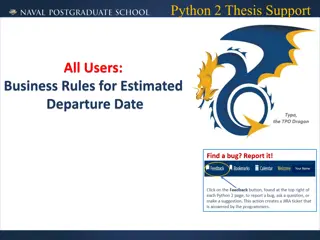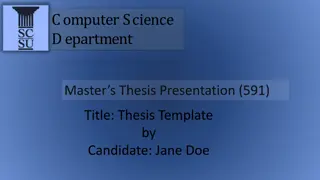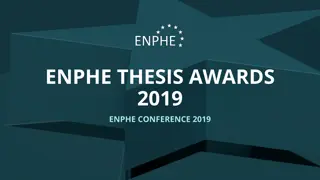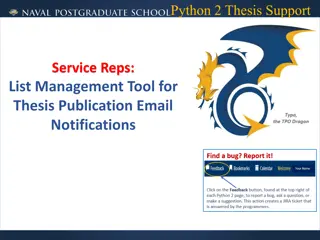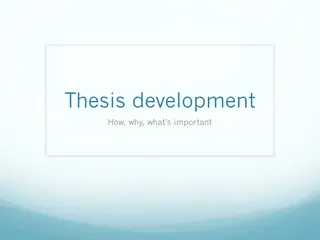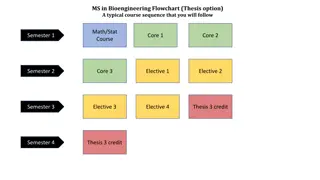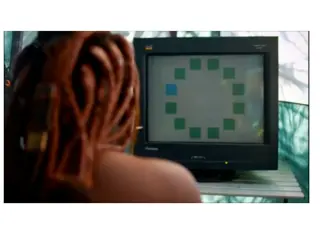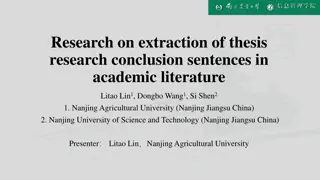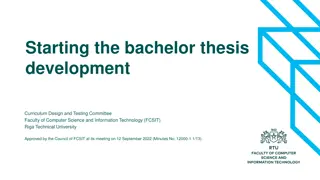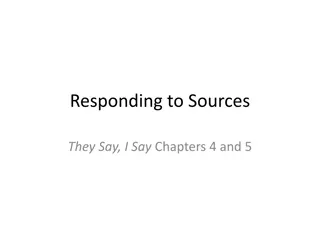
Comparison of Tranexamic Acid and Bleomycin for Malignant Pleural Effusion Management
Malignant pleural effusions (MPE) present a significant clinical challenge, impacting patients' quality of life and survival rates. This thesis protocol explores the effectiveness of tranexamic acid and bleomycin as pleurodesis agents in managing MPE, aiming to provide better symptom relief and prolong survival. The study addresses the urgent need for improved therapeutic interventions in the management of MPE, highlighting the importance of prompt symptom relief and cost-effective strategies.
Uploaded on | 0 Views
Download Presentation

Please find below an Image/Link to download the presentation.
The content on the website is provided AS IS for your information and personal use only. It may not be sold, licensed, or shared on other websites without obtaining consent from the author. If you encounter any issues during the download, it is possible that the publisher has removed the file from their server.
You are allowed to download the files provided on this website for personal or commercial use, subject to the condition that they are used lawfully. All files are the property of their respective owners.
The content on the website is provided AS IS for your information and personal use only. It may not be sold, licensed, or shared on other websites without obtaining consent from the author.
E N D
Presentation Transcript
WELCOME TO THESIS PROTOCOL PRESENTATION DR. HASIB AHAMED MS (Thoracic Surgery) Phase-B Resident National Institute of Diseases of the Chest and Hospital Mohakhali, Dhaka. 1
Title of the thesis Comparison of the effectiveness of tranexamic acid and bleomycin as pleurodesis agents in managing the malignant pleural effusion. 2
Introduction Pleural effusion represents a common manifestation of pleural diseases, encompassing various etiologies ranging from cardiopulmonary disorders to inflammatory or malignant conditions, and among the causes of pleural effusion, lung, and breast cancer account for a substantial proportion of malignant pleural effusions (MPE), contributing to significant morbidity and urgency in clinical management. In approximately 10% of cases, MPE presents as a massive effusion characterized by complete opacification of the hemithorax, necessitating immediate evaluation and treatment (Abd El Zaher and El Dib et al., 2020) (Saleh, Awad and Sanad et al., 2020). 3
Introduction Malignant pleural effusions pose a considerable medical challenge for patients with cancer, necessitating effective therapeutic interventions to alleviate symptoms and improve quality of life as patients with MPE experience significant reductions in their quality of life, facing symptoms such as progressive dyspnea, dry cough, chest pain, and limited physical activity (Ibrahim et al., 2015). Despite advances in cancer treatment, survival rates for MPE remain poor, with median survival ranging from 3 to 12 months, depending on the individual patient and tumor factors (Bibby et al., 2018)(Yang and Wang et al., 2023). 4
Introduction Therefore, effective management of MPE should prioritize prompt symptom relief, minimal discomfort, and preservation of everyday activities in a cost- effective manner (Saleh, Awad and Sanad et al., 2020). A retrospective cohort study observed that 97% of patients experienced a recurrence of malignant pleural effusion within one month (with an average of 4.2 days) after undergoing therapeutic aspiration (Ferguson et al., 1973). 5
Introduction In the context of recurrent and symptomatic MPE, the typical approach involves intrapleural instillation of a chemical substance with the goal of inducing pleurodesis, which involves the creation of adhesions between the parietal and visceral pleura. Pleurodesis has emerged as the most widely accepted palliative therapy for managing MPE, aiming to prevent fluid accumulation and alleviate symptoms related to pleural effusion, enhancing the quality of life, and reducing the need for repeated hospitalizations (Omoregbee and Okugbo et al., 2021). 6
Introduction Several agents have been employed for pleurodesis. However, despite the various options available, there is a lack of trials that conclusively demonstrate the superiority of any one substance over another in terms of treatment effectiveness. Therefore, the selection of the appropriate agent for pleurodesis presents a challenging decision-making process. The choice is influenced not only by the chemical agent's efficacy but also by factors such as safety, availability, cost, ease of use, and the number of administrations required to achieve a complete response (Abd El Zaher and El Dib et al., 2020) (Saleh, Awad and Sanad et al., 2020). 7
Introduction Among the frequently used agents in clinical practice worldwide are talc, bleomycin, and tetracycline derivatives. Talc is considered the most effective and commonly utilized agent for MPEs, although its use has been associated with severe complications such as acute respiratory distress syndrome (ARDS), and medical-grade talc may not be readily available in all regions (Bibby et al., 2018). 8
Introduction On the other hand, bleomycin, an antitumor antibiotic (Mohamed, Ali and Mahmoud et al., 2013), is a well-established pleurodesis agent, it acts through DNA breakage and free radical generation that trigger inflammation by releasing inflammatory cytokines and causing cellular damage in the pleura, promotes the deposition of fibrin, which serves as a scaffold for fibrosis. It also stimulates fibroblasts, which is responsible for producing collagen leads to the formation of adhesions in the pleural space. 9
Introduction Beside this, it also inhibit angiogenesis of tumor cell (the formation of new blood vessels) thus further contributing to the fibrotic process in the pleura (Hecht et al., 2000) (Adamson and Bowden et al., 1979). Bleomycin showing comparable efficacy to talc in inducing pleurodesis while having milder side effects like chest pain and fever (Mart nez-Morag n et al., 1997). However, its higher cost may limit its use in some cases (Muduly et al., 2011). 10
Introduction The search for the ideal agent for pleurodesis in MPE is still continues, and ongoing research aims to find a safe, effective, low cost, available, and accessible option to improve outcomes and enhance the quality of life for patients with MPE. 11
Introduction Under these circumstances, Tranexamic acid, a synthetic antifibrinolytic agent, (Mohamed, Ali and Mahmoud et al., 2013) has drawn the attention of the researchers. Tranexamic acid which is primarily used in various medical settings, including surgery, trauma care, and gynecology to reduce blood loss and the need for blood transfusions, is cheaper and more readily available globally. It has been reported as a promising agent for pleurodesis in some series. 12
Introduction Tranexamic acid has pro-inflammatory effect (Barrett et al., 2019), which acts through the promotion of fibrin formation (fibrin clots) in the pleural space and reduction of fibrinolysis by inhibiting the activity of plasmin, an enzyme that breaks down fibrin clots, tranexamic acid can reduce the breakdown of the formed fibrin in the pleural space and which acts as a scaffold for fibrosis and adhesion formation between the pleural layers (Cai et al., 2020). Some reports have recorded success rates of 95.5%. Tranexamic acid has been proven as a safe and effective alternative sclerosing agent for pleurodesis, however, not as extensively studied for MPE management. 13
Introduction Multiple studies have explored agents for pleurodesis in malignant pleural effusion. An Egyptian trial favored Tranexamic acid success (95.5%) over Doxycycline (81%) (Abdalla et al., 2023). Another Egyptian study noted 75% success with Tranexamic acid (Mohammed et al., 2015). Similar pleurodesis rates for Tetracycline and Bleomycin were found in a Spanish trial (Mart nez- Morag n et al., 1997). The Department of Surgery, NCI, Cairo University, reported higher success with Talc (85%) compared to Tetracycline (60%) (Mourad et al., 2004). 14
Introduction Talc was favored over Bleomycin in an American University of Beirut Medical Center study (Rafei et al., 2015). An Iranian trial observed comparable rates between Povidone-Iodine and Bleomycin (79% vs. 75%) (Alavi et al., 2011). A study by Tanta University in Egypt favored Tranexamic acid over Iodopovidone (88% vs. 76%) success for pleurodesis (Abd El Zaher and El Dib et al., 2020). Another Egyptian study from Chest Department of Benha University Hospital reported success with Tranexamic acid (75%-90%) compared to Bleomycin (60%-80%) (Mohammed, Eisa and Abdelghaffar Hibah et al., 2015). 15
Introduction However, there is limited comparative data on their effectiveness in the management of MPE, particularly within the healthcare system of Bangladesh. Bangladesh characterized by a dense population and a high burden of malignancies, necessitates focused research to determine the optimal pleurodesis agent for managing MPE within its tertiary care hospitals. The aim of the current study is to compare pleurodesis with tranexamic acid and bleomycin as palliative preventative therapies for recurring MPE in terms of effectiveness (success rate), economic costs, available agent, and safety (side effects). 16
Introduction Additionally, the study aims to evaluate the safety profile of the two agents, assess the incidence of complications, and analyze patient-reported outcomes, including pain relief and improvements in quality of life. By evaluating their effectiveness and comparing outcomes, this research seeks to provide evidence- based guidance to healthcare professionals, enabling them to make informed decisions regarding the selection of the most suitable pleurodesis agent within this specific clinical context. 17
Introduction The findings will inform healthcare professionals regarding the selection of the most effective and safe pleurodesis agent, ultimately leading to improved patient outcomes and enhanced quality of care for individuals suffering from MPE in tertiary care hospitals. Furthermore, this research will contribute to the ongoing search for the ideal pleurodesis agent, helping to optimize treatment protocols and advance patient-centered care in the management of MPE. In a search for an effective, safe, cheap, and available agent, the present study aimed to evaluate the effectiveness and the safety of tranexamic acid versus bleomycin as a chemical agent for pleurodesis. 18
Rationale of the research The rationale for conducting this study is to bridge the knowledge gap regarding the comparative effectiveness of tranexamic acid and bleomycin as pleurodesis agents for malignant pleural effusion (MPE) in the context of Bangladesh's healthcare system. Despite the common use of these agents, limited data exist on their comparative efficacy in this specific clinical setting. By conducting a comparative investigation, this study aims to provide evidence-based guidance to healthcare professionals in Bangladesh regarding the selection of the most effective pleurodesis agent for managing MPE. 19
Rationale of the research This research is crucial for optimizing treatment protocols, improving patient outcomes, and enhancing the quality of care provided to individuals suffering from MPE in tertiary care hospitals. Furthermore, the study will contribute to the ongoing search for the ideal pleurodesis agent by expanding the current understanding of tranexamic acid and bleomycin in the context of MPE management, ultimately advancing patient-centered care and addressing the unmet needs in this area of research. 20
Research Hypothesis Tranexamic acid is more effective than bleomycin as a pleurodesis agent in the management of the malignant pleural effusion. 21
Objectives General Objective: To compare the effectiveness of tranexamic acid and bleomycin as pleurodesis agents in achieving successful pleurodesis in patients with malignant pleural effusion in a tertiary care hospital in Bangladesh. Specific Objectives: To determine the success rate of pleurodesis achieved with tranexamic acid in patients with malignant pleural effusion. To determine the success rate of pleurodesis achieved with bleomycin in patients with malignant pleural effusion. 22
Objectives To compare the success rates of pleurodesis between tranexamic acid and bleomycin as pleurodesis agents. To ascertain the relative safety profiles of both agents. To evaluate the cost-effectiveness of utilizing tranexamic acid as a pleurodesis agent as compared to bleomycin. 23
Materials and methods- Study design: Comparative cross-sectional study. Place of study: Department of Thoracic surgery, National Institute of Disease of the Chest and Hospital (NIDCH), Mohakhali, Dhaka. Period of study: 12 months after approval of the protocol. 24
Materials and methods- Study Population: The study will be carried out on patients with malignant pleural effusion who underwent chemical pleurodesis in the department of thoracic surgery, NIDCH after fulfilling the inclusion and exclusion criteria. Sampling Method: All consecutive patients fulfilling the enrollment criteria will be included in this study from the day of enrollment. Convenient sampling technique will be applied. 25
Materials and methods- Sample Size ?= ?1(1 ?1)+?2(1 p2) (??+??)2 (?1 ?2)2 Here, Z?: the Z-score for the desired significance level (e.g., for a 5% significance level, 1.96); Z?: the Z-score for the desired power (for 80% power 0.84) p1: The success rate of tranexamic acid= 90%= 0.90; p2: The success rate of bleomycin= 60%= 0.60 (Mohammed, Eisa and Abdelghaffar Hibah et al., 2015) ?= 0.90(1 0.90)+0.60(1 0.60) (1.96+0.84)2 = 28.746667 (0.90 0.60)2 Therefore, for this researcher, it requires a minimum of 28 participants for the study in each group. 26
Materials and methods- Selection Criteria Inclusion criteria: All patients with symptomatic malignant pleural effusion will be included in this study after obtaining informed written consent and fulfilling following criteria: Age more than 18 years, both male and female will be included. Malignant pleural effusion. Underwent tube thoracostomy. Patients who will able to comply with the study requirements and follow-up visits. 27
Materials and methods- Selection Criteria Exclusion criteria: Patients with following characteristics will be excluded from the study: Unwilling to participate. No prior intrapleural instillation therapy. Those who will receive systemic bleomycin previously. Patients with unsuccessful lung re-expansion after tube thoracostomy due to malignant pleural effusion. 28
Materials and methods- Selection Criteria Exclusion criteria: Patients with contraindications or known allergies to tranexamic acid or bleomycin. Patients with significant comorbidity that may increase the risk associated with pleurodesis like- Coagulopathy or Bleeding Disorders, Immunocompromised patients, COPD, CKD, DVT, and also for Pregnancy and Breastfeeding mother. 29
Materials and methods- Variables Dependent variables: Outcome of pleurodesis depends on- Treatment response: Complete, Partial, Failure. Follow-up chest x-ray. Duration of IT tube remained. Total hospital stays. Independent variables: 1. Chemical pleurodesis by tranexamic acid. 2. Chemical pleurodesis by bleomycin. 30
Materials and methods- Variables Confounding variable: 1. Socio-demographic characteristics- Age, Sex, Weight. 2. Pre-procedure complaints: Dyspnea, Cough, Chest pain. 3. Pre-procedure chest x-ray. 4. Effusion side. 5. Method of diagnosis (Cytology, Closed pleural biopsy or Thoracoscopic biopsy). 6. Total chest drainage fluid. 7. Total drug cost for the procedure. 31
Materials and methods- Operational Definitions Recurrent malignant pleural effusion: Re-accumulation of a significant amount of exudate in the pleural space after aspiration, accompanied by the presence of malignant cells or tumor tissue, and/or pleural biopsy reveals positive for malignant cells (Antony et al., 2001)(Abd El Zaher and El Dib et al., 2020) Pleurodesis: Obliteration of pleural space by inducing an aseptic inflammatory response to achieve definitive and long-standing pleural apposition with fibrosis (Muduly et al., 2011). 32
Materials and methods- Operational Definitions Tube thoracostomy: Tube thoracostomy involves making a hole in the intercostal space into the pleural cavity (blindly or with image guidance) under aseptic precautions with the placement of a secured tube for continuous drainage into a water-sealed container (Muduly et al., 2011). Radiological evidence of pleural effusion: Chest radiograph in erect position in posterior-anterior (PA) view, and in lateral decubitus view helpful to detect the pleural effusion like- blunting of the costophrenic angle, blunting of the cardio-phrenic angle, meniscus formation, mediastinal shift (however, in cases 33
Materials and methods- Operational Definitions where coexisting lung collapse is present, the mediastinal shift may occur toward the side of the effusion). Lateral decubitus view tend to be more sensitive in identifying even smaller amounts of fluid because the costophrenic angles are deepest at their posterior aspect (Karkhanis and Joshi et al., 2012). Pain score: Following the numeric rating scale (NRS) 0: no pain 1 to 4: mild pain 5 to 8: moderate pain 9 to 10: severe pain (Walker, Polaner and Berde, et al., 2018). 34
Materials and methods- Operational Definitions Dyspnea: Subjective experience of breathing discomfort that consists of qualitatively distinct sensations that vary in intensity (Berliner et al., 2016). Scored following MRC (Medical Research Council) scale (Stenton, 2008) MRC grade 0 Breathless with strenuous exercise 1 Short of breath when hurrying on the level or walking up a slight hill 2 Walks slower than people of the same age on the level or stops for breath while walking at own pace on the level 3 Stops for breath after walking 100 meter 4 Too breathless to leave the house or breathless when dressing Description Degree None Slight Moderate Severe Very Sever 35
Materials and methods- Operational Definitions Prerequire of pleurodesis: Lung should be expanded both clinically and radiologically. Drainage will be less than 150ml/24hours. No air leaks. Condition for IT removal: When post procedure drainage will <100ml/24hours. Duration of IT remained: It is the total time of IT kept after pleurodesis. Hospital stays: The duration of pre-procedure and post procedure stay, until discharge. 36
Materials and methods- Operational Definitions Response to pleurodesis: Response to pleurodesis will be defined as following three categories: Complete response: Symptomatic improvement with complete radiographic resolution of the pleural effusion. Partial response: Symptomatic improvement with recurrent pleural effusion that will not require additional tube thoracostomy. Treatment failure: Recurrent pleural effusion that will require tube thoracostomy on follow-up (Ibrahim et al., 2015) (Mohammed, Eisa and Abdelghaffar Hibah, et al., 2015) 37
Materials and methods- Operational Definitions Outcome: In this study, the outcome will include- Efficacy of pleurodesis. Safety of pleurodesis agents in terms of complications like the presence or absence of pain and fever after the intervention. Relative costs of the comparative agent. Recurrence of pleural effusion in malignant condition in 2nd week and the 4th week after the procedure. 38
Materials and methods- Operational Definitions Participants' symptom (including pain and dyspnea) during follow-up. Duration of IT remained. Duration of hospital stay in days. 39
Materials and methods- Procedure Technique Patients and methods: All the patients having malignant pleural effusion who will fulfill the inclusion and exclusion criteria will be divided into two groups: group A and group B in a simple randomized manner. In both groups, tube thoracostomy will be done under local anesthesia through the 5th intercostal space just lateral to the anterior axillary line and connected to an underwater sealed tube drainage system. The drainage will be controlled to avoid the development of re- expansion pulmonary edema. 40
Materials and methods- Procedure Technique The patient will commence chest physiotherapy with an incentive spirometer to encourage lung re-expansion. As soon as the drainage is less than 150 ml/24hours, no air leak and the lung fully re-expanded (verified by clinically and by chest x-ray), pleurodesis will be performed at the patient s bedside. Group A: Who will receive intrapleural Tranexamic acid (30 mg/kg, [maximum of 2g] in 50 mL of normal saline) will be administered through a chest tube. Group B: Who will receive Bleomycin (1 U/kg [maximum of 60 U] in 50 mL of normal saline) will be administered through a chest tube. 41
Materials and methods- Procedure Technique The chest tube will be clamped for four hours and connected to a water seal bag. All patients will encourage for deep breathing exercise. Negative pressure will not apply to any of the patients. All patients will undergo the same post-pleurodesis physiotherapy and pain control protocols (if needed). When the post-procedure drainage is 100ml/24 hours, the chest tube will be removed. Chest x-ray will be done and if satisfactory, patients will discharge with advice for oncological consultation. 42
Materials and methods- Post procedure evaluation & follow-up Any complication related to the procedure such as fever, or allergic reaction will be recorded and managed. Follow-up will be done in the 2nd week and the 4th week after the procedure. During follow-up, the response to the procedure, treatment failure, and the complaints of the patients like dyspnea and pain will be evaluated. The efficacy of pleurodesis will be defined in three levels of response: complete, partial and failed. 43
Materials and methods- Post procedure evaluation & follow-up 1. Complete response means no radiographic evidence of fluid re-accumulation and no symptom, will be noted on follow-up. 2. Partial response means re-accumulation of fluid that will not produce symptoms and will not require repeat pleural drainage on follow-up. 3. Failed response means fluid re-accumulation that will produce symptoms and will require repeat pleural drainage on follow-up. 44
Materials and methods- Equipments to be used Data collection instrument: A standardized semi-structured questionnaire will develop in English. The questionnaire will be developed using the selected variables according to the specific objectives. The questionnaire will contain questions related to socio- demographic characteristics, and pre- and post-procedure parameters. A checklist containing some preset options will use to simplify data collection and decrease the chances of error in observation. Statistical measuring tools: Personal laptop with SPSS version 27.0 45
Materials and methods- Data collection procedure Data will be collected by means of the following techniques: 1. Face-to-face interview. 2. Reviewing necessary medical records of the patients. First of all, informed written consent will be taken from all patients or from relatives. All patients will be subjected to complete history taking, general, and local examination, routine laboratory investigation including liver function tests, kidney function tests, and coagulation profile, radiographic evaluation by plain chest x-rays (PA and lateral views) following tube thoracostomy. 46
Materials & methods- Procedures of data analysis for interpretation After collection of data, data processing and statistical analysis will be done with the help of SPSS version 27. Continuous variables will be reported as mean standard deviation or median with interquartile range. Categorical variables will be reported as numbers and percentages. All reported p values will be two-sided, and p values <0.05 is considered statistically significant. 47
Materials & methods- Quality assurance strategy It is extremely important that the data collection is good in quality, for that purpose at first manual work will be done. Then a sample size will be selected. A standard questionnaire will be made. The questionnaire will be pretested to ensure that the respondents will able to understand the questionnaire and answer accordingly. The Procedure will be done with aseptic precautions. Data should be cross-checked for consistency, correctness & any discrepancy. Appropriate measures will be taken in case of inconsistency, incorrectness, and discrepancy. 48
Materials & methods- Data presentation The summarized data will be presented in the form of tables and charts. Result Suitable tables, graphs, charts will show the results of the study after completion. Discussion Discussion will be made after obtaining the results in the study according to objectives with reference and cross reference. Conclusion Conclusion will be made upon the results and discussion with recommendation for further project. 49
Ethical considerations 1.Keeping compliance with Helsinki declaration of medical research involving human subjects 2011, all patients will be informed about the study design, the purpose of the study. 2. Participants will have the right to withdraw themselves from the research, at any time, for any reasons. 3.Written informed consent will be taken from the respondents. 4. No data will be disclosed without the permission of the respondents. 5. Permission will be taken from the academic and institutional review board (IRB) of National Institute of Diseases of The Chest and Hospital, Mohakhali, Dhaka, for conducting the study. 50


